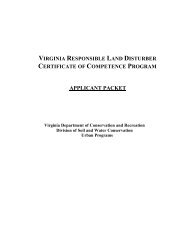Appendix 4-A - Virginia Department of Conservation and Recreation ...
Appendix 4-A - Virginia Department of Conservation and Recreation ...
Appendix 4-A - Virginia Department of Conservation and Recreation ...
Create successful ePaper yourself
Turn your PDF publications into a flip-book with our unique Google optimized e-Paper software.
Purpose <strong>and</strong> Need<br />
HB 2088 Report<br />
Executive Summary<br />
The 2009 Session <strong>of</strong> the General Assembly, through HB 2088 stated the following:<br />
“No later than December 1, 2009, the <strong>Department</strong> <strong>of</strong> Rail <strong>and</strong> Public Transportation, the<br />
<strong>Department</strong> <strong>of</strong> Game <strong>and</strong> Inl<strong>and</strong> Fisheries, <strong>and</strong> the <strong>Department</strong> <strong>of</strong> <strong>Conservation</strong> <strong>and</strong><br />
<strong>Recreation</strong> shall develop a process to coordinate <strong>and</strong> evaluate public recreational access<br />
<strong>and</strong> safety issues directly related to new railroad projects, if appropriate, that are funded in<br />
whole or in part by the Commonwealth, <strong>and</strong> shall send a report to the Chairmen <strong>of</strong> the House<br />
<strong>and</strong> Senate Transportation Committees communicating the results.”<br />
The <strong>Virginia</strong> <strong>Department</strong> <strong>of</strong> Rail <strong>and</strong> Public Transportation (DRPT), the <strong>Virginia</strong> <strong>Department</strong><br />
<strong>of</strong> <strong>Conservation</strong> <strong>and</strong> <strong>Recreation</strong> (DCR) <strong>and</strong> the <strong>Virginia</strong> <strong>Department</strong> <strong>of</strong> Game <strong>and</strong> Inl<strong>and</strong><br />
Fisheries (DGIF) developed these recommended processes <strong>and</strong> procedures. In order to<br />
accomplish this, staff from the respective departments held stakeholder meetings with<br />
representatives from CSX Transportation (CSX), Norfolk Southern (NS), the <strong>Virginia</strong> Railroad<br />
Association (VRA), Bike Walk <strong>Virginia</strong>, <strong>Virginia</strong> Bike Federation, Float Fishermen <strong>of</strong> <strong>Virginia</strong>,<br />
Friends <strong>of</strong> the Rivers <strong>of</strong> <strong>Virginia</strong>, Richmond Area Bicycling Association, local governments<br />
<strong>and</strong> other recreational user groups to gain input on the proposed process to address<br />
recreational <strong>and</strong> safety issues <strong>and</strong> consider public recreation access to new railroad projects.<br />
In addition, the departments consulted the <strong>Virginia</strong> <strong>Department</strong> <strong>of</strong> Transportation (VDOT)<br />
<strong>and</strong> the United States <strong>Department</strong> <strong>of</strong> Homel<strong>and</strong> Security, Transportation Safety<br />
Administration (TSA) for technical guidance on infrastructure design <strong>and</strong> safety parameters.<br />
In collaboration with the stakeholders above, the departments determined that a reference<br />
guide <strong>of</strong> design practices together with a process to identify <strong>and</strong> establish a recreational<br />
interface with rail lines would be an appropriate approach to the legislative m<strong>and</strong>ate. The<br />
agreed upon process for communication between the departments, host railroads <strong>and</strong> trail<br />
stakeholders is detailed in Section 2. This process establishes two opportunities for<br />
incorporating trails or pedestrian crossings. The first is through a trail proposal submitted to<br />
DCR who will then coordinate with the host railroad. The second is through identifying<br />
proposed Rail Enhancement Fund projects <strong>and</strong> cross-referencing with existing trail<br />
proposals, as identified by DCR.<br />
This report was developed to fulfill the requirements <strong>of</strong> HB2088. The report was reviewed by<br />
the various stakeholder groups <strong>and</strong> provides project development <strong>and</strong> design considerations<br />
for Rails with Trails/Pedestrian Crossings (RWT/PC) along the active right-<strong>of</strong>-way (ROW) <strong>of</strong><br />
railroads, with more specific considerations given toward the development <strong>of</strong> these trails in<br />
<strong>Virginia</strong>. <strong>Recreation</strong>al advocate groups have stated that RWT/PCs <strong>and</strong> public access<br />
alongside or adjacent to active rail lines in the Commonwealth <strong>of</strong> <strong>Virginia</strong> could serve as a<br />
link to a growing interconnected system <strong>of</strong> trails that run along the East Coast <strong>and</strong> through<br />
the Commonwealth. Railroad operators, however, have expressed concerns about the safety<br />
impacts to rail operations, liability <strong>of</strong> RWT/PC public access <strong>and</strong> the impact <strong>of</strong> liability in the<br />
design <strong>and</strong> decision process. Trail advocate groups believe that <strong>Virginia</strong> Code §29.1-509<br />
(<strong>Virginia</strong> L<strong>and</strong>owner Liability Law) could provide indemnification to the railroads for<br />
RWT/PCs. The railroads do not necessarily share the trail advocates’ confidence in the<br />
ii
















